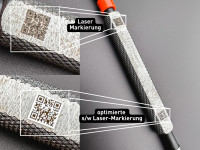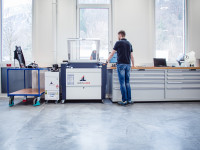Laser cutting of technical film: practical tips
Efficient methods and valuable advice for precise cuts
The laser cutting of technical film opens up a wide range of possibilities for the precise processing of film materials required in various technical applications. Laser cutting has proven to be extremely efficient and reliable, particularly in sectors such as the automotive industry, medical technology and electronics. Technical films often consist of challenging materials such as polyimide, polycarbonate or PET, which place high demands on the cutting technology. With a few practical tips and proven methods, the laser cutting of technical film can be optimally implemented.
What is technical film?
Technical film is a collective term for thin plastic films that are used in various industrial applications. These films can be made of different materials such as polyamide, polyester, polyethylene, polypropylene or polyvinyl chloride. They are characterized by their high resistance to chemicals, temperatures and mechanical stress.
Advantages of laser cutting technical film
Laser cutting offers numerous advantages over traditional cutting methods such as punching or cutting with mechanical tools:
- Precision: laser beams enable extremely precise cuts with minimal tolerances.
- Flexibility: Complex shapes and the finest details can be cut with ease.
- Clean edges: The laser leaves no burrs or rough edges, which reduces post-processing.
- Non-contact cutting: As there is no physical contact, damage to the film is avoided.
- Speed: High cutting speeds increase productivity.
Practical tips for laser cutting technical film
The following tips will help you achieve the best results when laser cutting technical film:
Choosing the right type of laser
The choice of the right type of laser depends on the specific properties of the technical film. CO2 lasers are particularly suitable for cutting non-metallic materials such as plastics. The right laser not only reduces processing time, but also minimizes the risk of thermal damage that can occur with thin film materials.
Setting the laser parameters
The correct setting of the laser parameters is crucial for the quality of the cuts. The laser power, cutting speed and focus position must be adapted to the material thickness and properties. An optimally focused laser beam reduces material removal and ensures clean edges without discoloration or deformation. The speed of the laser should be set so that the material does not overheat, but is cut fast enough to remain productive. Cutting too slowly can cause the material to melt, while cutting too quickly may leave unclean edges.
Avoiding material deformation through cooling techniques
Technical films are often sensitive to heat, which can lead to deformation or undesirable color changes. The use of cooling techniques, such as compressed air cooling, can minimize this effect. Cooling ensures that the heat generated during laser cutting is dissipated immediately. This is particularly important for thin films in order to reduce the thermal load on the material and ensure the quality of the end product.
Maintenance and calibration of the laser machine
Regular maintenance and calibration of the laser machine ensures that it works precisely and efficiently in the long term. By regularly cleaning the optics, checking the laser source and adjusting the cutting unit, optimum cutting results can be achieved even with high production capacity utilization. Especially when used for technical films, which are often required in sensitive applications, the consistency of the cuts is a decisive quality factor.
Use of suitable extraction systems
Laser cutting produces vapors and particles that can affect the working environment and cutting quality. A powerful extraction system ensures that these emissions are removed quickly and effectively. This not only contributes to safety in the workplace, but also extends the service life of the laser optics.
Optimizing the cutting strategy
The cutting strategy should be designed so that the film is moved as little as possible to avoid deformations and inaccuracies. A cutting table with a vacuum function supports perfect focusing by automatically fixing the material. It is advisable to carry out the cuts in a continuous process and to optimize the movement of the laser head in order to minimize production time.
Use of modern software for cutting optimization
Modern laser cutting systems offer software solutions that are specially designed to optimize the cutting process. These programs help to make the cutting path as efficient as possible, reducing the amount of material and time required. By simulating the cutting processes, the behavior of the material can also be predicted and potential problems identified before production begins. Such software enables constant quality assurance and maximizes productivity.
Application examples
Laser cutting of technical film is used in numerous industries. Some examples are
- Electronics: production of insulating films for printed circuit boards, flexible conductor tracks and display films.
- Medical technology: Cutting of precision templates, implant films and medical packaging.
- Automotive industry: production of seals, protective films and lightweight components.
- Packaging industry: production of blister packs, labels and sealing films.
Laser cutting of technical film offers numerous advantages and is an efficient and precise method for processing plastic film. By following the practical tips mentioned above, the best results can be achieved and production processes can be optimized. This technology will continue to play an important role in various industries in the future and open up new application possibilities.



